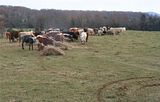If you ever have the opportunity, take your tractor out for a short drive on a sheet of ice. (We get a couple or three ice storms of greater or lesser degree each winter here on the average) You'll get a better picture of it's inherent handling characteristics. Just about everey tractor I've ever been on, even MFWD's, will tend to want to go straight (to some degree), even with steering input. Some more pronounced than others. They'll turn, but you'll notice the front end wanting to wash or push the front wheels. Same logic applies to a tractor in the dirt/on grass, only much less obvious.
That's why tractors commonly use ribbed tires. Those ribbed tires work in much the same manner as a rudder on a ship. If they WEREN'T digging in a bit, the front end would wash quite a bit more noticabley.
Sharp turns will amplify the effect. To minimize the resulting damage to turf, make more gradual, sweeping turns, learn to apply a very light touch to steering brakes, lower speeds, and make certain the front end is ballasted properly. And then, you know what? You'll still slide a wheel every now and then.
And on a final note. Yesterday, when I stopped at a dealer to pick up a few parts I ordered, I ran into the mechanic from the golf club where I play frequently. While waiting our turn, we got into a discussion about a Kubota mowing tractor they have. He mentioned how difficult it was to "square" the track vs wheel base because of the difficulty getting the front end wide enough. He said they always try to get a tractor almost as wide as it is long, or relatively close to minimize wheels scuffing as the turn. Next year when you're watching the Ryder Cup on TV, take a look at the grass and see what sort of job he did! ('08 Ryder Cup @ Valhalla Golf Club)


